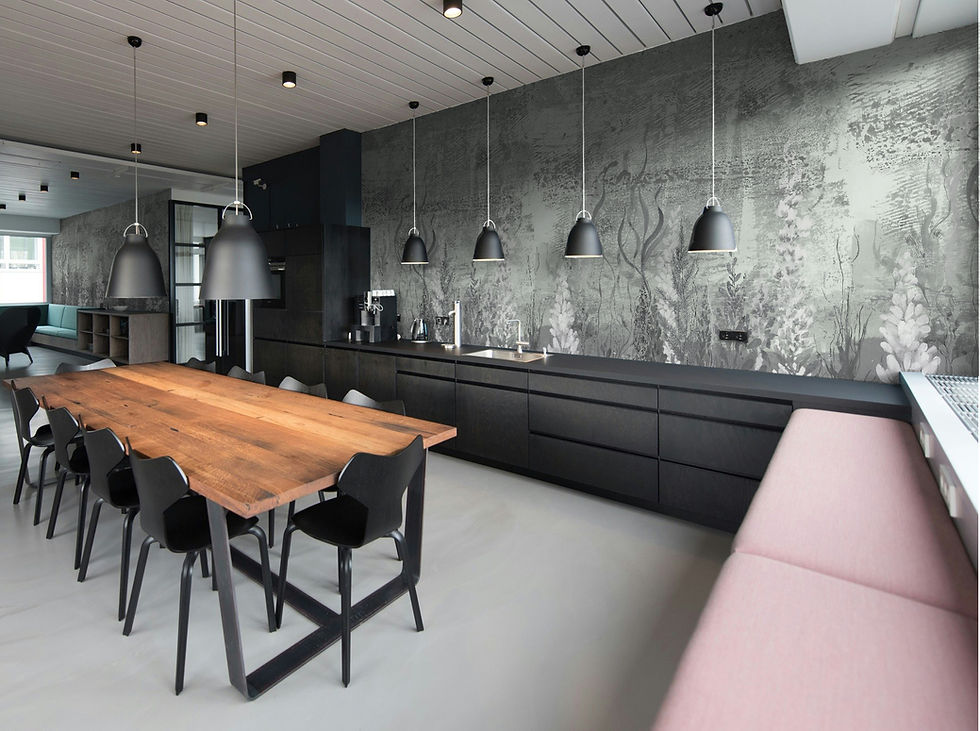Eco-Friendly Wallcovering Options for Your Home
- Guillermo
- May 6, 2023
- 3 min read
Creating a sustainable living space is more than just a trend—it's a responsibility we all share. One of the best ways to contribute to an eco-friendly home is through choosing environmentally friendly wallcoverings. These options not only help reduce your carbon footprint but also enhance the aesthetic appeal of your living space. In this post, we will explore several types of eco-friendly wallcoverings, their benefits, and practical tips for integrating them into your home.
Eco-Friendly Wallcoverings
When it comes to wall coverings, traditional options often rely on chemicals and materials that are harmful to the environment. Fortunately, there are a variety of eco-friendly alternatives that are safe for your home and the planet.
Recycled Wallpaper: Made from post-consumer waste, recycled wallpaper offers a fabulous way to add character without harming the environment. Brands are increasingly producing wallpapers that recycle materials like paper and plastic. This lowers landfill waste and uses fewer resources in production. Look for options marked as “made from recycled materials” for the best impact.
Natural Fabrics: Fabrics made from organic materials such as cotton, linen, and hemp are great for wall coverings. Natural fibers have much less environmental impact compared to synthetic fabrics. Besides being stylish, these materials are breathable, reducing indoor air pollution.
Cork Wallpaper: An innovative and eco-friendly option, cork wallpaper provides fantastic thermal insulation and sound absorption. Cork is harvested from the bark of cork oak trees without causing them harm, making it a sustainable resource. It also has natural anti-microbial properties, which are beneficial for a healthy living space.
Benefits of Eco-Friendly Wallcoverings
Switching to eco-friendly wallcoverings offers numerous advantages, both for the environment and your home.
Improved Indoor Air Quality: Many traditional wallcoverings contain volatile organic compounds (VOCs) and other harmful chemicals that can lower indoor air quality. Eco-friendly options are often free from these harmful materials, ensuring that your home remains a safe and healthy environment.
Sustainability: The materials used in eco-friendly wallcoverings often come from renewable sources, ensuring that your choices contribute positively to the earth. This helps promote sustainable practices in the manufacturing industry.
Energy Efficiency: Several eco-friendly wallcoverings offer enhanced insulation properties, which can help maintain a comfortable temperature in your home. As a result, you may find yourself relying less on heating and cooling systems, ultimately lowering your energy bills.
Practical Tips for Using Eco-Friendly Wallcoverings
Choosing eco-friendly wallcoverings is just the first step. Here are some practical tips to help you make the most of your sustainable choices:
Measure Your Space: Before you buy wallcoverings, measure your walls accurately. This helps ensure you purchase enough material for your project and avoid wastage.
Check Certification Labels: Look for certifications like FSC (Forest Stewardship Council) or Green Seal, which indicate that the product adheres to strict environmental standards.
Choose Low-Maintenance Options: Some eco-friendly wallcoverings are easier to maintain than others. Consider how much time and effort you’re willing to invest in upkeep when making your choice.
Mix and Match: Don't hesitate to combine different wallcoverings to achieve a unique look. You could pair bamboo panels with recycled wallpaper for a layered effect that showcases your commitment to sustainability.
DIY Installation: Many eco-friendly wallcovering options allow for easier DIY installation. If you have the time and skills, consider tackling the project yourself to save costs and personalize your space further.
Embracing Sustainable Design in Your Home
As you explore the world of eco-friendly wallcoverings, remember that your choices extend beyond just aesthetics—you're making a positive impact on the planet. By opting for sustainable materials, not only do you enhance your living space, but you also contribute to a healthier environment.
Creating a home that reflects your values doesn't have to compromise style. With so many innovative and beautiful options available, it’s never been easier to choose wall coverings that are kind to the earth. Whether you opt for cork wallpaper or recycled materials, your walls can tell a story of sustainability and care.
The journey toward an eco-friendly home starts with informed decisions. As you consider your next wall update, think about how your choices can resonate with both your style and your commitment to the planet. Embrace these sustainable practices, and transform your living space into a sanctuary that aligns with your eco-conscious mindset.







Comments